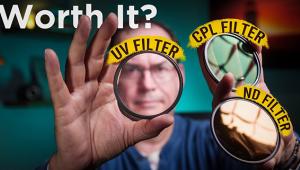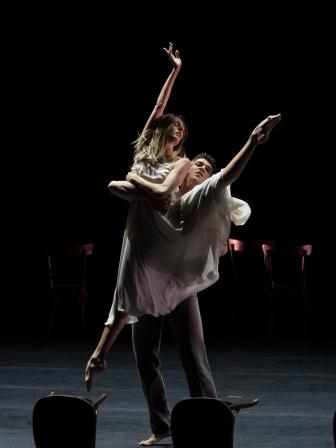The Sigma 8mm f/3.5 EX DG Circular
Courtesy of Sigma Corporation, All Rights Reserved |
There are two kinds of fisheye lenses, the rectilinear and the circular; the
rectilinear delivers right angle corners while the circular gives you just that,
a round image in a rectangular space. Both distort the heck out of the world.
This one yields a 180° angle of view, which means that if you point it straight
ahead you will usually get your shoes in the frame; in addition, you can point
the camera in one direction and no one alongside you will ever know you are
shooting their picture. Just as well, as anything that resides on the edges
looks decidedly warped.
The Sigma 8mm has a nice, fast maximum aperture of f/3.5 and an amazing close-focusing
distance of a bit over 5"--that's right, inches. At f/22 (which
I would not recommend for general use, but then again what's general use
with this lens?) you get surreal depth of field; even at f/8 it feels like any
kind of critical focusing is foolish. But if you are shooting close there are
distance marks on the lens in feet and meters that drop from the infinity mark
right to 1 meter and then downward to 0.135 meters (the scale is in feet and
inches as well). The lens can be used in AF mode and has Sigma's super
multi-coating and Special Low Dispersion glass. Construction is 11 elements
in six groups, with a six-bladed diaphragm.
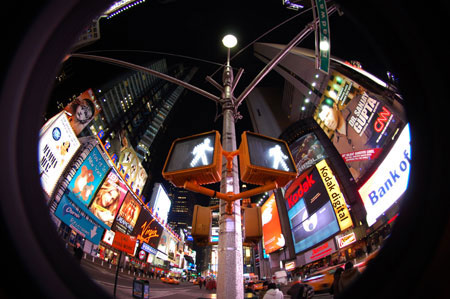 |
|
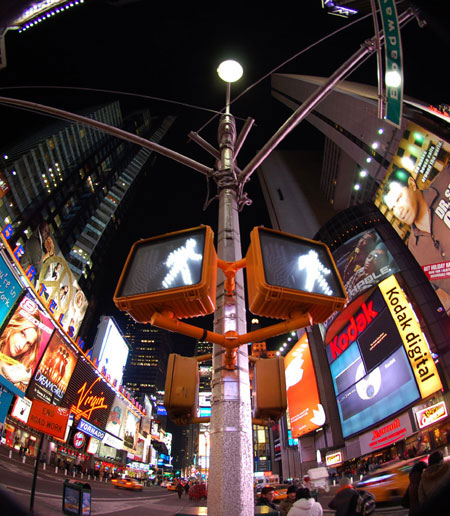 |
|
|
The lens is for 35mm and full-frame D-SLRs. This means that anyone shooting
an APS-C sensor D-SLR, and that's the vast majority of us, will get their
hemispheres clipped at the top or sides. I used it on a few Nikon and Canon
mount APS-C cameras and didn't feel deprived of the fisheye effect, although
it was a pretty good illustration of why you generally shouldn't use full-frame
lenses on APS-C sensor cameras.
According to Sigma, "The circular fisheye should always provide an Angle
Of View (AOV) of 180° anywhere along the diameter (about 22mm) of the circular
image. Most APS-C sensors will crop out parts of the top and bottom of the circle,
so the AOV in those areas will be reduced. The smaller sensors may also crop
out some of the left and right sides, so the AOV there will be reduced as well.
But, as long as the full diameter of the circle is captured the AOV should be
180°." The lens is available for Canon, Nikon, Sigma, Sony, and Pentax
mounts.
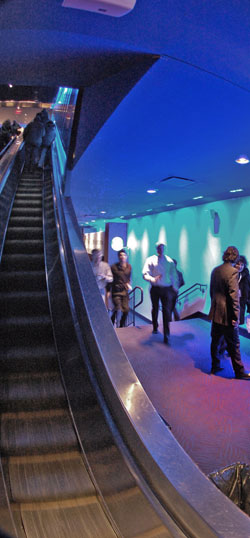 |
|
 |
|
|
My shooting covered interior and exterior locations. From the shots on the
card it looks like all I did was hang out in Times Square, but I shot around
other New York locales as well. Much of the shooting was at night and indoors
and that's where the f/3.5 max aperture and the ability to shift ISO on
the fly really came in handy.
For the most part I had fun with the lens and accepted the distortion as part
of the experience. You don't shoot fisheye only for a wide angle of view--you
go in knowing that edges will bend and vanishing points will get weird. If you
want a super-wide point of view without distortion get into stitching.
The current ability to construct images in many ways does bring up a point about
fisheyes in general. This focal length might be an analog remnant that is quickly
being replaced by distortion and perspective controls in software, thus making
it even more niche than it had been in the past. But there's no denying
that it's a fun way to see occasionally. You find yourself getting into
odd postures and looking for the most oblique angle on things. And it can be
used for both digital and film 35mm cameras (full frame), although there's
some cropping of the circle (thus angle of view) in APS-C. I also leave it to
your imagination as to what you can do with this sort of odd perspective image
once you get the file into the Transform menu of Photoshop and other such fun
houses.
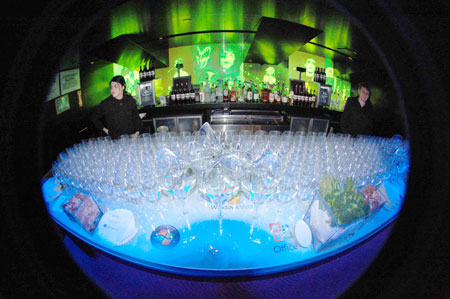 |
|
 |
|
|
While there's no question that the Sigma 8mm f/3.5 lens changes your
point of view, your decision is whether or not this $990 (MSRP; you might find
it for less) lens is something you'd use often enough to justify the expenditure;
if the answer is yes then the Sigma 8mm f/3.5 certainly delivers the goods.
For more information, contact Sigma Corporation of America, 15 Fleetwood Ct.,
Ronkonkoma, NY 11779; (800) 896-6858; www.sigma-photo.com.
- Log in or register to post comments






























